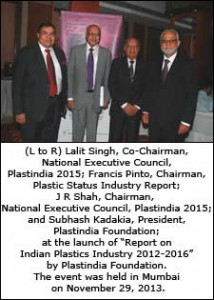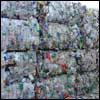Waste plastic is being increasingly used in road construction and this trend is expected to gain prominence in the coming years. This was highlighted at an event in Mumbai marking the launch of an exhaustive study on the plastics industry by Plastindia Foundation.
 Titled “Report on India Plastics Industry 2012-16” the study, covering several aspects of the industry, was aimed at being a useful knowledge resource for all stakeholders. Elaborating on the use of waste plastic in the road construction sector, J.R. Shah, Chairman of the National Executive Council, PlastIndia 2015, explained that adding plastic waste to the asphalt during road construction improves the water-bearing capacity of the asphalt and makes roads more durable. PlastIndia 2015 is the 9th International Plastics Exhibition & Conference to be held in New Delhi during February 5-10, 2015. India currently recycles (reuses) 3 million tonnes of plastic and road construction is one such recycling avenue, Shah noted. While it was not yet mandatory for road building agencies to use waste plastic, several entities including government local bodies are taking the initiative, he said.
Titled “Report on India Plastics Industry 2012-16” the study, covering several aspects of the industry, was aimed at being a useful knowledge resource for all stakeholders. Elaborating on the use of waste plastic in the road construction sector, J.R. Shah, Chairman of the National Executive Council, PlastIndia 2015, explained that adding plastic waste to the asphalt during road construction improves the water-bearing capacity of the asphalt and makes roads more durable. PlastIndia 2015 is the 9th International Plastics Exhibition & Conference to be held in New Delhi during February 5-10, 2015. India currently recycles (reuses) 3 million tonnes of plastic and road construction is one such recycling avenue, Shah noted. While it was not yet mandatory for road building agencies to use waste plastic, several entities including government local bodies are taking the initiative, he said.
The report highlighted that India was a growing market for plastics. India’s current annual consumption was 11 million tonnes as against the global consumption of 275 million tonnes. By 2016, domestic consumption is estimated to grow to 16.5 million tonnes. As much as 4.8 million tpa of plastic and polymer capacity is scheduled to come up in the near future, as per known capex plans of companies, the report observed.
The report projected that consumption of thermoplastic polymer would go from 11 million tonnes in 2012-13 to 20 million tonnes by 2020. Flexible packing industry accounts for 35 per cent of this consumption, followed by industrial applications with 14 per cent and rigid packing with 13 per cent. Infrastructure is turning out to be a significant consumer with a current share of 12 per cent, the study noted.











